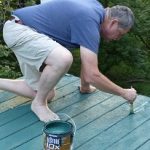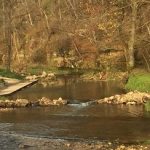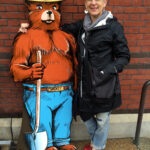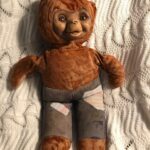by Winding Pathways | Jun 27, 2020 | (Sub)Urban Homesteading, Reflections/Profiles
We are fully into summer and still pausing as SARS-CoV-2 and the subsequent disease COVID-19 resurges. So, looking back how did you manage from Mid-March through now? What interesting activities did you do? How did you connect with Nature? How did you nurture yourself? What did you do for others? Make a short comment that I’ll review, sort through and share some.
We did the usual projects at home and in the yard. Then, we found that taking regular forays in the truck around town exploring different neighborhoods helped acquaint us with Our Town. Weekly we took day trips to natural areas and made short videos for families to see. Our interactions with others were minimal and always at a distance. People nodded, waved and we all went on our way.

Painting small deck
Projects: scrubbed the porch and deck railings. Re-sealed the big deck and painted the posts. Cut wood. Hauled wood from downhill to uphill. (naturally!)Stacked wood. Cut more wood. Hauled more wood. Stacked wood. Refreshed the woodstove room with new paint. Sorted and discarded “stuff.” Planted the garden. Painted the inside of the barn. Built birdhouses. Watched the birds court, nest, raise young.

Yellow River State Forest
Activities: Walked nearly daily. We found it best to walk less frequented places. Rode Bikes. Took in many ZOOMs through various organizations. Attended church via ZOOM. Increased our blogging and FBLive with Hoover’s Hatchery. Maintained our schedule with Winding Pathways. Day tripped to Ram Hollow, Matsell Bridge, Wildcat Den St. Pk., Hopped a car ferry across the Mississippi, skirted the River, crossed to Iowa and lunched at Yellow River St. Forest. Explored Ciha Fen twice. Foraged wild spring greens like nettles and lamb’s quarter. Slept in our tent in the backyard two nights between bouts of rain. Overnighted at Beaver Creek Hollow State Park and came away drenched.

Oreo discovered carrot tops.
Since we were home so much of the time and with no travel in sight, we got back in the bunny business. We adopted a black and while hybrid “Lionhead” bunny named Oreo. She needed a new home. So, we said, yes. She is funny, shy, thumps when she wants attention, and squeaks.
by Winding Pathways | Jun 6, 2020 | Reflections/Profiles
We wish that we could have sat on our back deck with George Floyd and the policemen who caused his tragic death. This may sound strange. Yet, we know the healing power of nature. We wish that they and all could experience the peacefulness of the trees, grasses, flowers and blue skies.
This brutal act of George Floyd’s and others’ deaths have appalled us. We extend our thoughts and compassion to Floyd’s family and all people and their families and friends who have been the victims of overt and subtle racism. We are all people and everyone deserves to be treated with respect, compassion, and decency.
We believe that being in nature soothes the soul, calms emotions, and stimulates curiosity. It blunts the edge of aggression and hate. In this time of both disease and racial challenges, we invite everyone to find a place of quiet natural beauty, absorb its calming embrace, and emerge with a dedication to make ours a fair and just world for all.
by Winding Pathways | Apr 23, 2020 | Mammals, Nature, Reflections/Profiles, Uncategorized, Wonderment
A few months ago, we posted a blog honoring Smokey Bear on his 75th birthday. Smokey was created by the United States Forest Service in an effort to encourage people to be careful with fire. His was one of the most successful marketing campaigns in history.

The allure of Smokey Bear.
Smokey is adorable yet commanding. When he said to drown campfires and snuff out cigarettes you did it without question. Today, we know that forest fires are a natural phenomenon with beneficial ecological impacts, but Smokey’s message still resonates.
Two Winding Pathways readers shared their memories of Smokey Bear.
Tracy McPartland of Cedar Rapids sent us a photo of her with Smokey taken at the Smithsonian. “I loved Smokey Bear as a kid. I used to voice imitate him even though I don’t know what his voice was like.”

Smokey has been well-loved.
Jim Rainey is a retired US Army LTC who lives in Pennsylvania. Recently, he told us he received a Smokey doll from Santa in the early 1950s when he was four or five years old. “I was enchanted by Smokey. And, my doll still sits on the chair in my office. Sometimes my dog uses him as a pillow. At age 65, or so, he has patches on his jeans, is missing some hair, and part of his nose is gone. A few years ago, we asked our three daughters what they wanted of our stuff and was surprised when our oldest daughter said she wanted Smokey. Before then I was thinking of having him put in my casket, but I really didn’t want him locked in a box for eternity. I’ll let my daughter enjoy him and think of me,” he said.
Rich also has pleasant memories of Smokey and passed his image whenever he entered the Boise, Clearwater, or Idaho Panhandle National Forests during his college years. In 1974 he was a US Forest Service Hot Shot and fought three wildfires in Idaho. He’s kept a Smokey poster on his office wall for years.
There is confusion. Technically he’s Smokey Bear, not Smokey THE Bear.
A former college contact, the Fazio Family, owns Woodland Catalog Smokey Bear Gifts and has a store in Moscow, Idaho. Anyone wanting Smokey items can order it online. There’s a Smokey Bear museum in a state park in Capitan, New Mexico. You can take a brief virtual tour at
Smokey endures for the ages. His message is clear, and his presence is endearing.
by Winding Pathways | Jan 30, 2020 | (Sub)Urban Homesteading, Reflections/Profiles
Background
I’ve been a dedicated walker all my life. As a young person wandering the woods, a biologist tromping the Alaskan tundra, a nature center director leading groups of kids afield, and as a birder, backpacker, and cross-country skier I’ve put a lot of miles on my 70-year-old joints. My iPhone says I’ve averaged about 11,000 steps a day for the past four years. If extrapolated backward that’s about 240 million flexes on my knee joints!
Several years ago, my physician treated me for elevated blood pressure (BP) with meds that I didn’t like taking. I asked her if increasing my physical activity might reduce my blood pressure. She said, “Give it a try.” I did and expanded my walking and added some simple daily weight exercises. It worked. After about six months my BP fell into the normal range. I tossed out the meds and kept exercising.
Then an ironic problem arose. In early 2019 my left knee started to hurt. Really hurt. A few months later the right knee followed suit. My doc prescribed an X-Ray that revealed cartilage worn thin. I was caught in a dilemma. If pain caused me to reduce walking, my blood pressure would rise. Not good. Medical science started steering me toward knee replacement. However, I wanted to try other solutions first. Sooner or later knee surgery may be needed but after almost a year of experimenting with ways and places to walk and what shoes are best, I’m able to stay physically active and reduce, but not completely eliminate the knee joint pain.
Pain Meds
My family physician suggested I try over the counter pain medications to reduce knee swelling and pain. I tried Ibuprofen, aspirin, and acetaminophen at different times. None reduced swelling or seem to diminish knee pain, so I rarely use them during the day. I do occasionally take them if my knee hurts at night when I’m trying to sleep.
Where I Walk
I usually walk in three distinctly different places. Cedar Rapids has several paved trails that circle two lakes and make for interesting walking. I found that the unyielding hard paved surface adds to knee pain. Other area trails are surfaced with crushed limestone. It’s firm but less hard than pavement and seems to create less knee pain than asphalt. My third walking area is nearby woodlands, grasslands, and lawns. It involves walking on dead leaves, grass or dirt pathways in the woods. These surfaces create the least discomfort: Lesson: Where I walk has a bearing on knee pain.
How I Walk
When knee pain appeared each step hurt, and I walked gingerly. I took shorter strides and climbed stairs slowly and deliberately. I eventually learned that a quicker pace and longer strides reduced knee pain. And, as I walk knee pain gradually subsides. It doesn’t completely go away but diminishes after the first quarter mile or so. It would be easy to simply give up after a few steps and retreat to a chair, but that’s counterproductive. Lesson: Walk briskly and don’t give up if the first few hundred steps hurt.
Footwear
For most of my life, I’ve worn hard-soled hiking boots, often with distinct and high heels, like a cowboy boot. After my knees started hurting, I began experimenting with many types of shoes, insoles, and boots. I believe that the hardness/softness of shoes and soles along with the angle the shoes create for the lower legs has a strong bearing on knee pain. The high heeled stiff boots I once wore produced the most pain. The most comfortable boots for me have soft cushioning soles and a shallow or no heel. Some shoes are very “squishy”. They have thick very soft soles. They made walking on hard surfaces more comfortable but have a major disadvantage. Whenever I walk on a side slope the squishy soles have some give to them and this puts side pressure on my knees. It hurts. I’ve also experimented with various insoles. Some make the shoes more cushioning and have helped. They also slightly change the angle where my lower leg joins the knee.
Footwear Lesson One: The type of footwear and insoles I wear lessens or worsens knee pain. Finding the right combination is by trial and error. My favorite footwear for cool weather walking on hard surfaces is crepe-soled leather boots with only a shallow heel. These are often used by carpenters who spend hours every day on their feet.
Footwear Lesson Two: Quality shoes and boots are expensive but they seem to fit better, are more comfortable and last longer than cheaper counterparts. Put money upfront. The cost of a quality pair is trivial if they reduce pain.
My Advice
My knees may continue to deteriorate to the point where I need knee surgery, but altering my shoes and boots and changing how and where I walk has helped reduce pain and may be all I need. I hope so but won’t hesitate to seek medical help if the pain worsens.
Everyone is different and what works for me to reduce knee pain may not work for others. However, I feel many people can reduce pain by finding the right combination of shoes/boots/insoles that produce the least knee pain and walking on the most comfortable surfaces at the pace that produces the least discomfort.
How to Know When to Seek Medical Help
When My knees began hurting and I experimented with ways to reduce it, I wondered how to know when it’s time for knee surgery. I asked Matt Schmitz, Physical and Integrated Wellness Program Manager at the Nassif Community Cancer Center, and his advice was superb. “When pain causes you to not do the things you like it’s time to take action,” he said. It’s good advice.
I’m not a physician and recognize that everyone’s body is different. What works for me may not work for someone else. Over the counter pain medications, for example, might help others even though they seemed ineffective for me. The trick is finding a combination of footwear, medication, and exercise that reduces knee pain.
st
by Winding Pathways | Jan 26, 2020 | Nature, Reflections/Profiles
News Reports and Remembering
Recent photos of burned and displaced kangaroos and koalas from massive Australian wildfires are heartbreaking and bring back memories of both fighting and setting fires in American woods and prairies.
As a 24-year-old US Forest Service Hot Shot back nearly 50 years ago I had the good fortune to help contain three wildfires in Southern Idaho. One left a memory of towering flames roaring up a steep slope toward my crew as we hurriedly dug a fire line parallel to the ridge. I wielded a chainsaw, dropping pines and firs toward the approaching flames. It was noisy, hot, and scary but our line, with the help of an airplane that dropped a load of “slurry”, stopped the blaze.
Not All Fires Respond the Same
Just a year later I lit a fire in dry prairie grass at the Dillon Nature Center in Hutchinson, Kansas. It roared onward until stopped dead by a mowed path. Green grass doesn’t burn.
We burn our prairie and oak woodland at Winding Pathways every year, usually in the fall because we know that our land, like much of North America, needs fire for good ecological health.
Misleading Reporting
Evening news stories about the terrible destruction of wildfires can be misleading and are never complete because:
* They show the most incinerated place in a vast burned area. Sometimes the land is not nearly so consumed by the fire.
* They never follow up. Months after a burn the same spot is lush with green growth and spangled with wildflowers.
Fire is as much a force of nature as rain and wind. Yes, they destroy houses in their path. Remember, often these were built in the woods without the fire-resistant construction recommended by the US Forest Service. In North America, fires don’t destroy forests or grasslands. They invigorate them.
Every year we look forward to abundant wildflowers and healthy grass in areas we’ve burned. But what about wildlife caught in a rapidly spreading fire? I’ve had the opportunity to watch rabbits, birds, deer, and even elk respond to flames. They don’t panic. Rabbits simply seem to hop to places unlikely to burn. So do deer. Snakes and some insects might enter holes and tunnels in the ground. Some are probably cooked. Baby animals would be unable to flee flames. Fortunately, spring fires, when babies are helpless, are rare.
2019 marked a huge fire event. It was Smokey the Bear’s 75th birthday! I love Smokey. He is one of the most successful marketers ever convincing people to drown campfires and snuff out matches. Smokey was so successful that fires became rare enough for plenty of dead wood to accumulate in Western Forests. That, combined with climate change, helped create the conditions for the catastrophic fires that have burned in recent years. Smokey’s message was a little off, but he’s still a loveable character.
Here is how he came to be. In 1950, after the Smokey Bear character was created, a singed bear cub was found after a fire. He lived for years in the National Zoo in Washington, DC. Known as Smokey, millions of people saw him until his death in 1976. He’s buried near the Smokey Bear Museum in Capitan, New Mexico.
An outstanding website about Smokey and wildfires is sponsored by the US Forest Service. If you are ever in Moscow, Idaho, be sure to stop at the Smokey Bear store on Main Street.
by Winding Pathways | Jan 19, 2020 | 1080 Labyrinth Blog, Reflections/Profiles
Labyrinths have been integral to this year’s activities. Locations have spanned from the East Coast to the deep South, and from Alaska to Hawai’i. Catch up with Winding Pathways’ 2019 walks at 1080 Laughing Labyrinth website.
May you enjoy labyrinth walks in 2020. Join Veriditas Council for a Qualifying Workshop for those interested in learning more about labyrinths. For trained facilitators a Renewal Day in Rapid City, SD, April 25, 2020.
Solvitur Ambulando.





